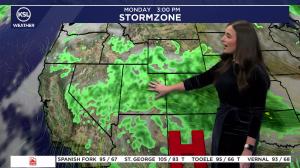Estimated read time: 2-3 minutes
This archived news story is available only for your personal, non-commercial use. Information in the story may be outdated or superseded by additional information. Reading or replaying the story in its archived form does not constitute a republication of the story.
SALT LAKE CITY — Archaeologists have found something significant out in the alkali flats of the Utah Test and Training Range in the state's west desert: steps.
The record of human steps that were left behind is a step toward better understanding life in Utah long ago, predating pioneers by thousands of years.
Scientists were on the way to another mission at the firing range used by the United States Air Force when they found the human-made impressions that turned out to be a massive discovery.
Anya Kitterman, the cultural resource manager on the project, said Thomas Urban, a man on her team, recognized something while looking out the window.
"He goes, 'Those are tracks,' " Kitterman said. "We found about 88 footprints — a mix of adults and children."

She said it is only the second location in the U.S. where such footprints from a specific age have been identified. She said they date back approximately 12,000 years, to what is known as the Paleo-Indian period.
The unexpected find came in the midst of a pilot program that uses ground-penetrating radar and magnetometry to search for other artifacts.
"Ten thousand years ago that west desert was a marshland. This is all part of the old riverbed delta," Kitterman said.
Air Force officials said they will continue to study the site as they go to great lengths to protect it. Tribal members joined scientists at the site to observe the footprints.
"They were able to go out and view it side by side with us," Michelle Cottle, the site's tribal liaison officer said."And it was really special for them to find their histories right there."
We're getting more and more pieces to a puzzle to understand what this culture was and who these people were.
–Anya Kitterman, cultural resource manager
It is hoped that with more time, more answers will surface.
"Everyone is fully on board in preserving these remains, protecting these remains and minimizing any sort of impact we might have," Kitterman said. "We're getting more and more pieces to a puzzle to understand what this culture was and who these people were."
Other finds at the range include a fire pit believed to be 12,300 years old.
The other found footprints from this era in the U.S. were discovered at White Sands National Park in New Mexico.









